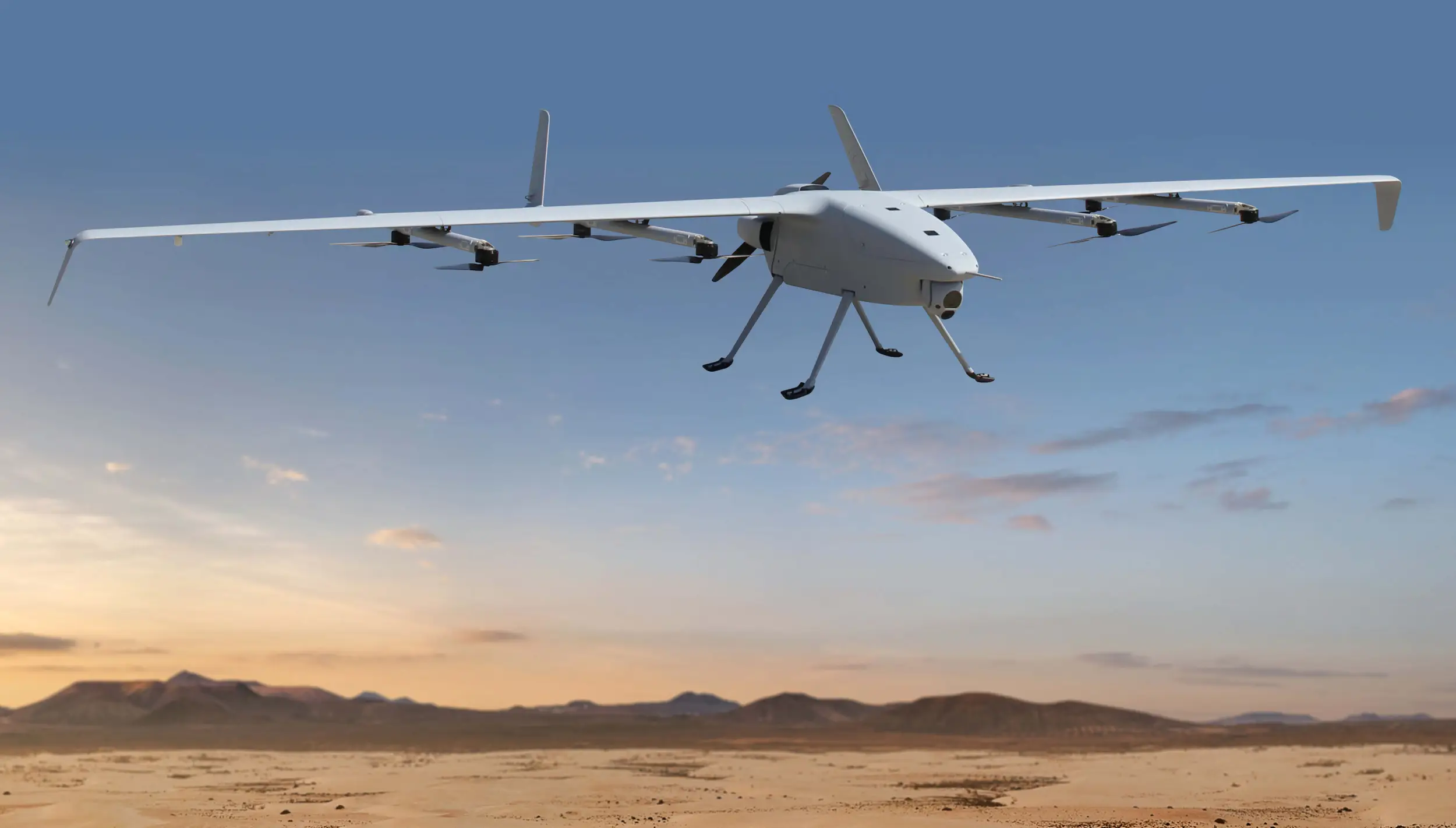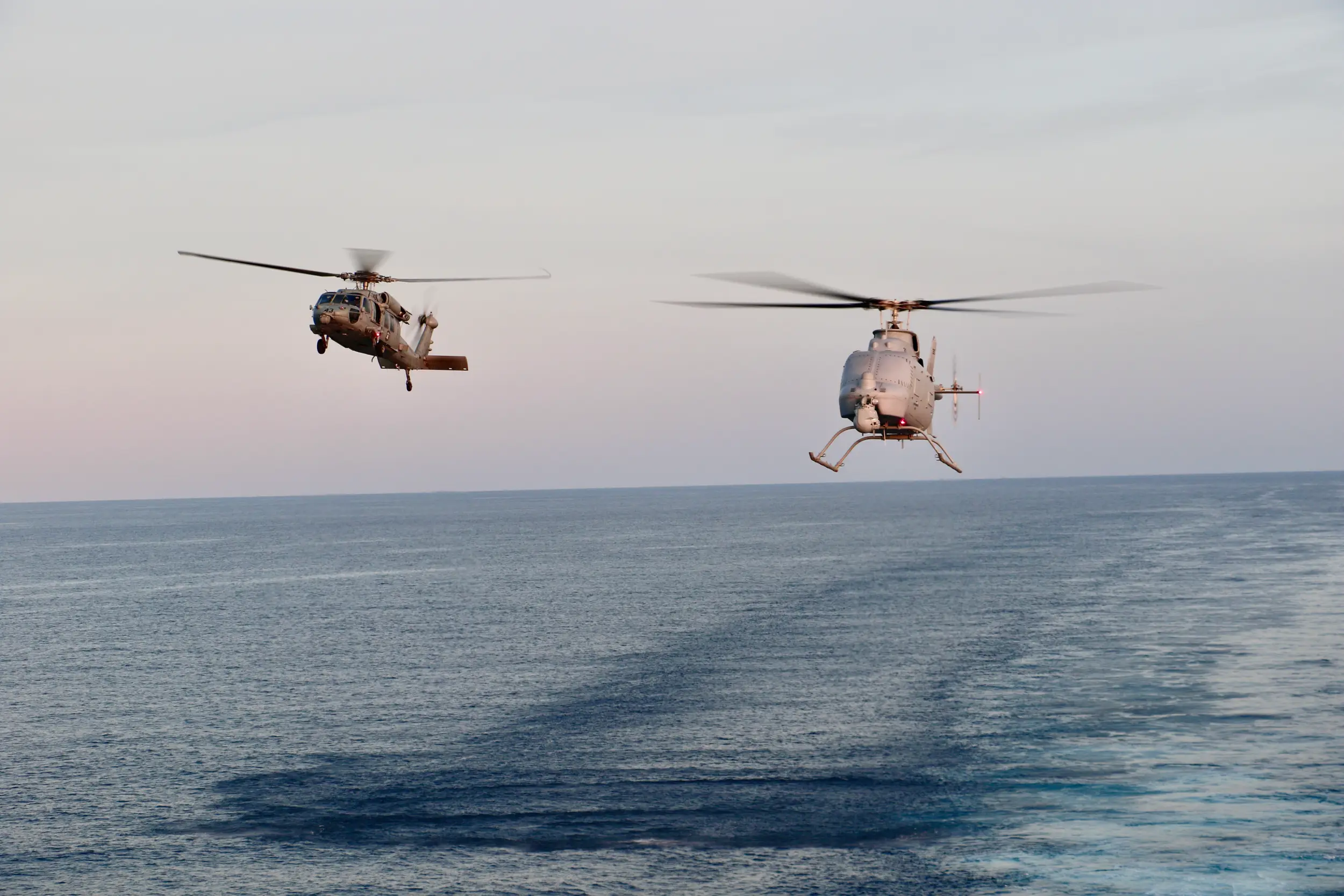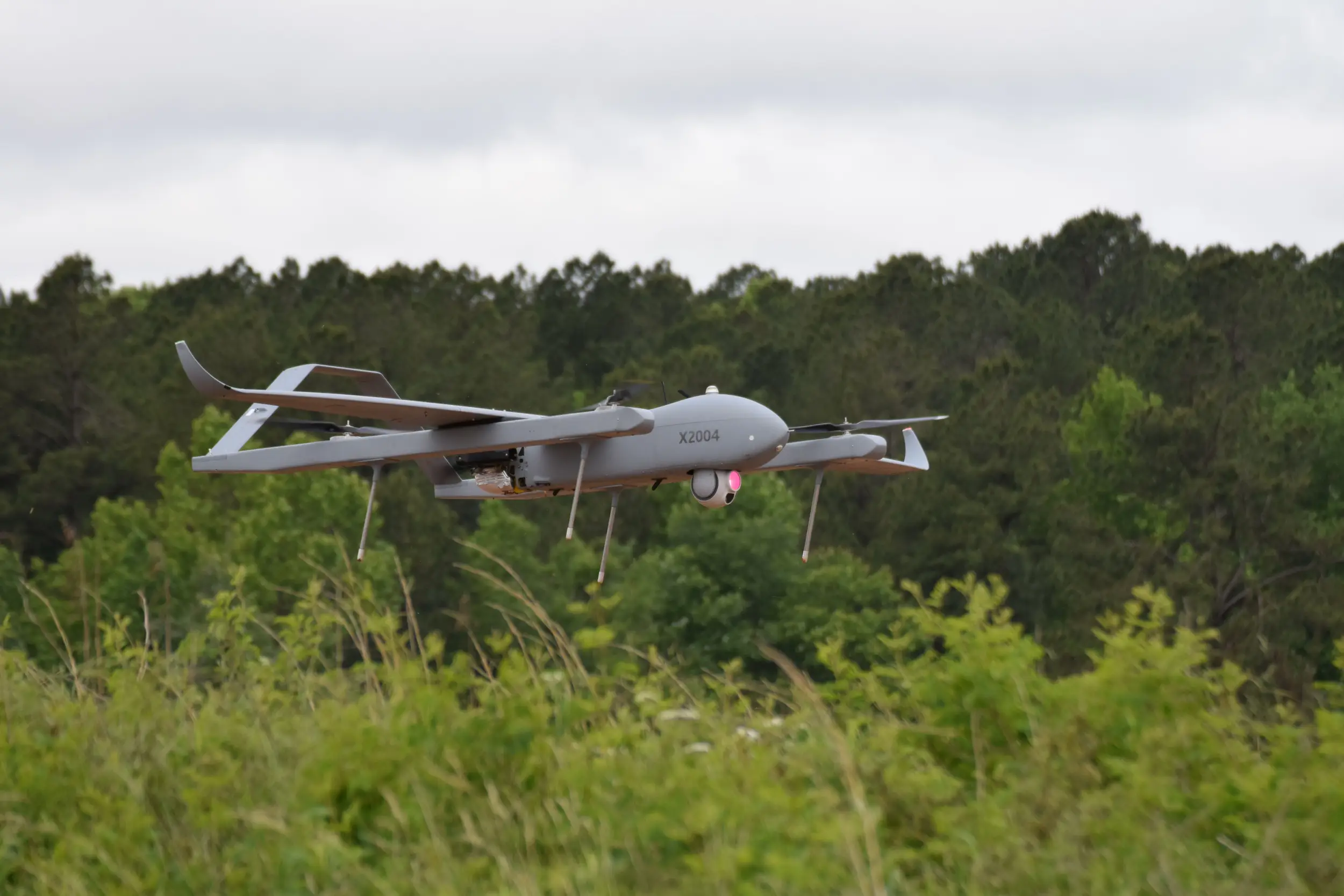
REPORT HOME > expanding the envelope
APRIL 2023 | technology report | ROTARY-WING UAS
The capabilities of the latest generation of VTOL UAS are bringing new deployment options and mission sets to commanders on land and at sea.
Above: The Voly-50 from Sierra Nevada Corporation is designed for ISR missions, and can operate autonomously or via remote control. (Photo: Sierra Nevada Corporation)
Vertical take-off and landing (VTOL) UAS have the potential to significantly enhance the intelligence, surveillance and reconnaissance (ISR) capabilities of armed forces, extending operational ranges and offering benefits in logistics footprints.
Military and industry experts see numerous opportunities for technological advances ahead, while continuing to meet the demands posed by size, weight and power (SWAP) concerns.
Foremost among the militaries aiming to benefit from these ISR capabilities is the US Army, which has launched the Future Tactical Unmanned Aircraft System (FTUAS) Increment 2 (Inc 2) competition as part of its Future Vertical Lift (FVL) programme.
This aims to improve brigade combat teams’ ability to collect, develop and report actionable intelligence information about enemy forces in environments with degraded GPS.
The winning vehicle will replace the RQ-7 Shadow UAS, notably, a fixed-wing design with no VTOL capability In February 2023, the army said it had awarded rapid prototyping Other Transaction Agreements (OTAs) to AeroVironment, Griffon Aerospace, Northrop Grumman (teamed with Shield AI), Sierra Nevada Corporation and Textron Systems.
Paradigm shift
Jason Waggoner, of the US Army’s Office of the Chief of Public Affairs, said VTOL UAS would provide military formations with an expeditionary capability that supports the ground manoeuvre force required for future conflicts and large-scale combat operations.
‘It is a paradigm shift from our current enduring fleet that would allow replacing the long logistical support and sustainment footprint of the Shadow UAS with a more agile, modular, and smaller footprint associated with a VTOL system,’ he added. ‘This enables a system that can take off and land without a runway and can provide faster responses.’
Waggoner said VTOL systems and small-form-factor ground control stations (GCS) would allow units to fly the system independent of a shelter or truck, as is the case with the RQ-7: ‘The system can be flown from a tactical vehicle, or in a standalone configuration with a minimal logistical or sustainment footprint.’
Brandon Tseng, president and co-founder of V-BAT designer and manufacturer Shield AI, and a former Navy SEAL, told Shephard that VTOL UAS offered advantages to military commanders beyond flexibility in deploying ISR assets. These include greater safety of operation, a small logistics footprint, mobility, stealth, payload capabilities and cost efficiency.
He emphasised the need for a modular open systems approach (MOSA) architecture in VTOL UAS, which he said is essential to offer long-term adaptability. Pointing to areas of recent technological development, Tseng highlighted the use of modular wingtips, which the company has added to V-BAT for the FTUAS bid. The aim is to improve lift and endurance, he said, while also providing a built-in antenna.
Gorik Hossepian, product line general manager for medium UAS at AeroVironment – manufacturer of the Jump 20 and Vapor 55MX VTOL UAS – emphasised the advantage of runway independence and the ability to quickly launch and deploy ISR platforms in a variety of locations.
‘VTOL UAS also add to the tactical and strategic nature of warfighting by eliminating the need to operate from predetermined areas that can support large ground-based operations,’ he added.
Meanwhile, Bill Leonard, senior director of programmes at Sierra Nevada Corporation, manufacturer of the Voly-50 and Voly-T systems, highlighted a range of technological developments applied to the system. For example, he noted that many Group 2 and above VTOL UAVs deploy hybrid technology, with lift motors and rotors powered by batteries, while forward flight uses an internal combustion engine for increased power and endurance.
The transition between vertical and forward flight and vice versa with gusts and turbulence during take-off and landing means more complex autopilots and flight management systems are required. ‘Continued advancements in power systems, sensors and algorithms provide VTOLs with a distinct tactical advantage over conventional systems, making them the primary choice for new acquisitions and deployments,’ Leonard said.
VTOL at sea
VTOL UAS are carving a particular niche in ISR for naval operators, a focus for Northrop Grumman’s MQ-8C Fire Scout system. The company’s director of FVL, Bob August, said maritime operations require ‘the autonomous capability to land very accurately on a platform that’s heaving, pitching and rolling… technologies have advanced to improve guidance solutions and provide capabilities such as obstacle avoidance when landing ashore in unprepared environments’.
A VTOL UAS is useful on board smaller ships in particular – such as the US Navy’s Littoral Combat Ship (LCS) – because it gives surface commanders greater situational awareness combined with a small logistics footprint, said Scott Weinpel, business development manager at Northrop Grumman. A ship’s radar horizon is usually restricted to 20-30nmi, while the use of a VTOL UAS can extend this to an additional 150nmi, he said.
Above: VTOL UAS are carving a particular niche in ISR for naval operators, a focus for Northrop Grumman’s MQ-8C Fire Scout system. (Photo: Northrop Grumman)
This relies at a basic level on AIS, the ability to identify ships that transmit a particular code, as well as an AESA radar system, which is the Leonardo Osprey 30 onboard the MQ-8C. An ISR picture is then built through a mission management system.
The future will involve a beyond line of sight (BLOS) capability, Weinpel said, requiring a technological upgrade for VTOL UAS. For example, the C2 link for Fire Scout is via the Tactical Common Data Link (TCDL), providing the range of 150nmi noted above. To go beyond this, the company aims to incorporate a SATCOM C2 system on board the aircraft, which he said could extend range to 600nmi or beyond.
There is also work to experiment with more advanced data links. ‘We would like to put an Advanced Tactical Data Link on board the aircraft so that it could share in real time – with other aviation and potentially surface assets – that common operational picture that it’s seeing.’
Elsewhere, Neil Hunter, global head of business development at Schiebel, said the company has seen interest from both armies and navies in the employment of VTOL UAS like its Camcopter S-100, but that most interest had come from the naval domain, with rotary-wing solutions in particular offering advantages in strong winds and high sea states and requiring a minimal footprint.
One example of a payload fit for the system is an EO/IR camera, a Thales I-Master radar and AIS. Hunter emphasised the need for such VTOL UAS to integrate a wide range of sensors for ISR, such as ‘the latest EO/IR cameras, wide-area optical scanners for land and at sea, enabling the UAS to find, track and detect suspicious activities’.
For his part, Richard Hjelmberg, VP business development at UMS Skeldar, also pointed to the applications of VTOL UAS in maritime scenarios, which are the key focus for the company’s V-200 rotary-wing system. Like the Camcopter S-100, the system can deploy sensors including EO/IR, AIS and a sea surveillance radar designed for tactical UAV usage.
‘Suddenly the recognised maritime picture that you can have becomes extremely large, allowing the ship commander to be able to do many more missions on his own.’ This would be particularly beneficial for those on smaller budgets.
SWAP challenges
Turning to challenges around SWAP, Hjelmberg said that sensor suppliers have worked to reduce their payloads in size and weight to be suitable for tactical UAVs. There is an ongoing need to provide ‘a very small logistical footprint’, he emphasised.
AeroVironment’s Hossepian said that by their nature, tactical UAVS are limited by SWAP. He said this underlined the importance of an open systems architecture approach, with the company adopting this approach for the Jump 20, meaning operators can integrate different payloads as needed: ‘The balance to strike is between endurance and payload capabilities, while maintaining the versatility of the UAV.’
Looking forward, Shield AI’s Tseng said the value of aircraft like VTOL UAS is in becoming more concentrated in software-driven competencies.
‘This means procurement decisions will be driven by software engineering and modular open systems trends as opposed to hardware characteristics, thus necessitating a shift in resources from legacy platforms to the development of AI capabilities. This shift is essential as the future of warfare will rely on… adaptability of forces, and systems that are not reliant on persistent reachback to remote resources.’
Above: The Aerosonde family of systems takes a MOSA-enabled architecture to ‘pack as much mission capability as possible into the smallest possible form factor’. (Photo: Textron Systems)
Wayne Prender, senior VP for air systems at Textron Systems, which produces the Aerosonde Mk 4.8 Hybrid Quadrotor, said that SWAP is the most critical factor in maximising UAS utility. He said the Aerosonde family takes a MOSA-enabled architecture to ‘pack as much mission capability as possible into the smallest possible form factor’. For instance, this allows for multi-mission capability for distributed maritime operations.
Sensor capability is advancing rapidly, with a need to integrate multiple capabilities quickly, Prender added. Additionally, autonomy and autonomous behaviours have been an integral aspect of uncrewed systems for a number of years. The company has incorporated these into its Aerosonde platforms to reduce support crew size and boost system reliability.
‘The next steps in autonomy, currently being developed and tested by industry, will enable greater mission flexibility and system survivability in contested environments, while reducing cognitive workload on system operators to allow them to focus on other critical aspects of the mission,’ Prender said.
Sierra Nevada’s Leonard added that as technology matures, reductions in SWAP will allow for increased endurance, along with improvements in payloads and navigation.
‘Autonomy is a focus area for VTOL UAVs to augment the dull, dirty and dangerous missions set in contested environments, with missions ranging from unmanned cargo resupply on land or at sea, to reconnaissance, surveillance and target acquisition (RSTA),’ he said. ‘Advances in navigation and sensing technologies, such as Assured Positioning Navigation and Timing (APNT) and vision-based navigation, are key enablers to enhance functionality, especially in degraded or denied GPS environments.’
The direction of travel is clearly towards more capable VTOL UAS, able to operate in a wider range of environments with a lower logistics footprint than their fixed-wing counterparts.


